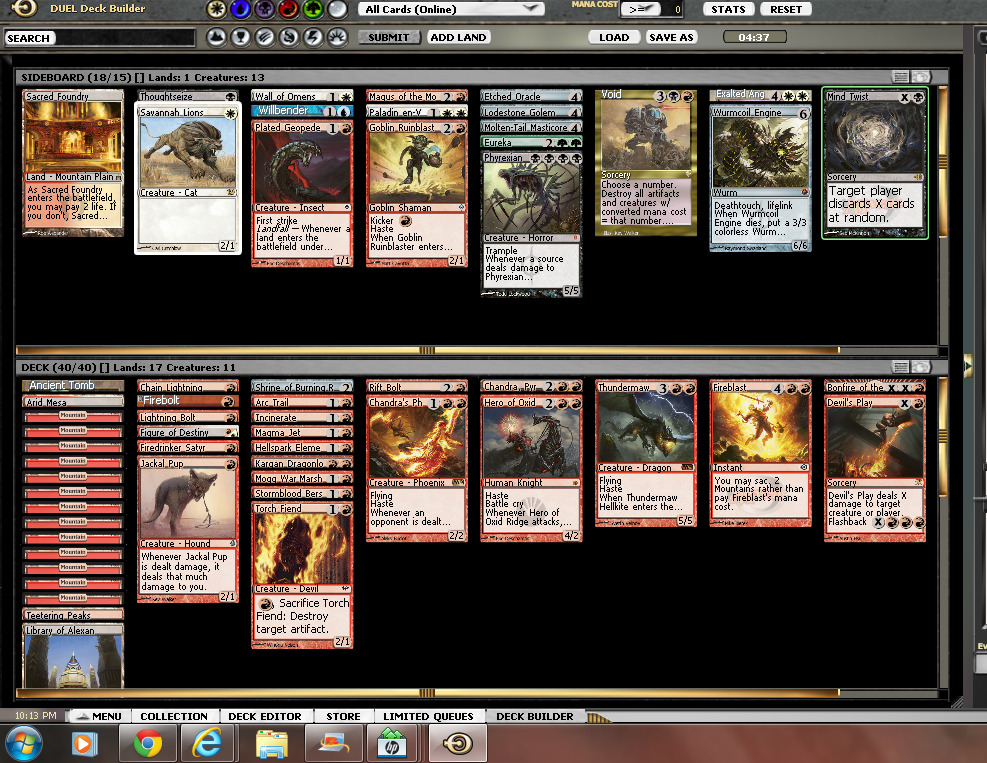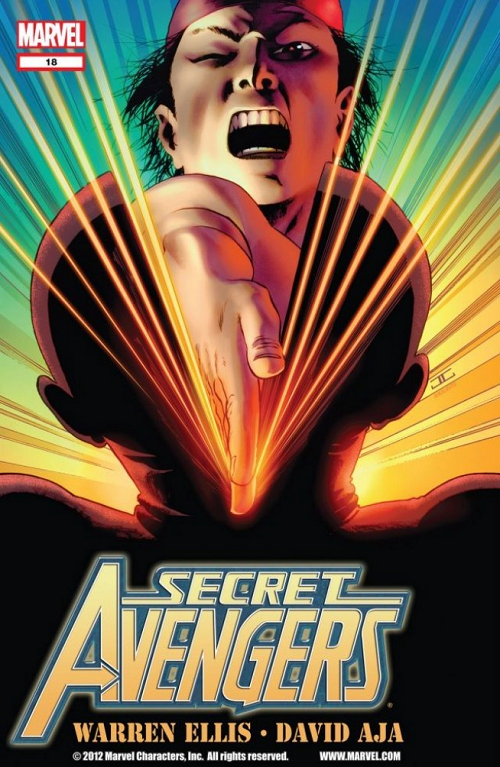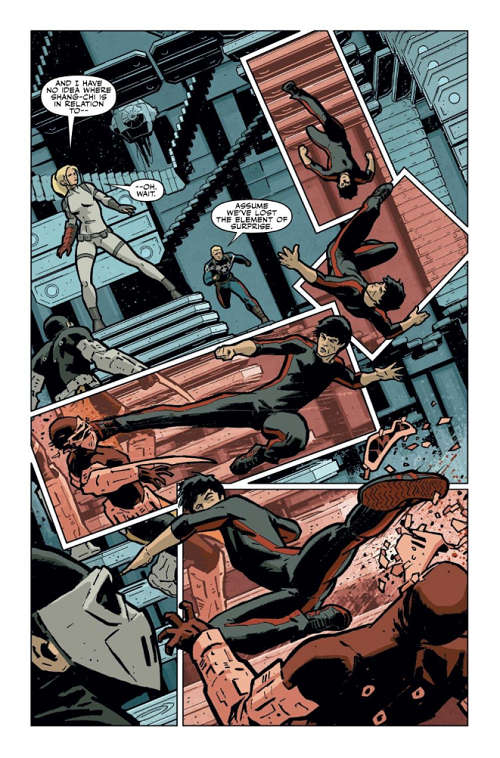Entries from January 2014 ↓
January 14th, 2014 — Magic, Reviews
You don’t click into Serious Fun during a preview week with the expectation of seeing the next Thundermaw Hellkite.
But this week on Bruce Richard’s column over on the Mother Ship, that’s exactly what you get (kinda sorta half the time).
D(jk2m2389/41KfQyd3sS_EN.jpg)
Flame-Wreathed Phoenix
Flame-Wreathed Phoenix is kinda sorta a split card.
With the punisher Tribute in full force you have a card that half the time is a Rathi Dragon with no drawback and half the time a Talruum Minotaur (-Phoenix!) with wings.
Rathi Dragon was a powerful card for some versions of the Red Deck (in particular in mirror matches in its day); and as I noted in my original review of Bloodbraid Elf there was a time when Talruum Minotaur was capable of contributing to a Pro Tour Top 8 Constructed deck.
And now… More flying!
So… What’s the damage on this card? Why so casual?
I think I can imagine Flame-Wreathed Phoenix being played in serious Constructed decks. Even just as a 3/3 flying creature it gains a re-buy ability reminiscent of most of Magic’s many Phoenixes. This is powerful the same way that Chandra’s Phoenix is powerful. It’s kinda sorta built-in card advantage. For one more mana, you get a slightly bigger hasty flyer. As someone who has enjoyed smiting opponents with Chandra’s Phoenix, I can appreciate a flying, resilient, Talruum Minotaur-Phoenix.
The rest of the time it is just a 5/5 flyer for four mana. It’s like you took Juzam Djinn and erased the awful Nettletooth Djinn-ness and replaced it with the universal sign for not being blocked.
One side of this card I can see getting behind; the other side is just a mana less than Thundermaw Hellkite, which is an insane proposition.
Is the punisher Tribute dilemma really that big a deal?
Browbeat is a similar card that seems to have good value on both sides. For 2R you either get to draw three cards (better than most blue equivalents about the same cost) or you brain your opponent for five (better than most red equivalents at the same cost). Good and also good. But Browbeat, despite being legal in multiple Standard Constructed formats over the years, never really made its mark on history.
(Though Philosophy of Fire innovator Adrian Sullivan did at one point Day Two a Pro Tour with Browbeat in his Red Deck.)

Hollywood
What was the problem with Browbeat?
Could this same problem limit the love given to poor Flame-Wreathed Phoenix?
Mere efficiency is a limitation. Yes, five damage for 2R is a good deal and three cards for 2R is a great deal. But you don’t generally want your opponent dictating to you which good / great deal you are getting. Think about the sheer number of times you have probably beaten a Vexing Devil. Am I vexed? I’ve been Vexed, sure. I think I generally have a good win percentage over Vexing Devil decks. Which is weird because I would gladly pay R for a 4/3 creature and I would generally love to pay R to deal four damage.
Sadly, my guess is the flexibility afforded the opponent will make Flame-Wreathed Phoenix even less successful over time than Vexing Devil.
Is 2RR a good deal for a 5/5 flying creature? I think so.
Is 2RR a good deal for a 3/3 flying creature with haste and a built-in re-buy? I think you are on rougher ground there. I did say I could appreciate it, but it is another matter committing to the card. At four mana, it’s not good enough to win the game on its own consistently, and you might just be stuck with a lot of land committed to doing very little against an able opponent.
On a punisher — SORRY. TRIBUTE. — scale, where would you put this card?
Vexing Devil > Browbeat > Flame-Wreathed Phoexix
That is my guesstimate.
This is the kind of card that I really want to be good because it looks cool; but I am not really sold on.
By the way last week Patrick Chapin reminded me that I gave basically the same preview rating to Rakdos Pit Dragon that I gave to Jace, the Mind Sculptor at snap judgment time.
In my meager defense, they made Rakdos Pit Dragon a Top Decks preview card; I assumed it was as good as, say, Lightning Helix (okay, this is a lie).
I think I see this as a role player; it has some attrition applications and could also, ahem, punish players who can’t easily deal five damage to a creature. Though it is kind of atrocious against Anger of the Gods.
Love,
Mike
(just kidding)
LOVE
MIKE
January 13th, 2014 — Magic, Reviews
This just spoiled:
D(jk2m2389/wXHJZFYuK6_EN.jpg)
Pain Seer
Second toughness.
Sometimes — but not all the time — a Dark Confidant.
Better or worse than Bob?
My first impulse was that Pain Seer is worse, generally, than Dark Confidant. For example, presuming you have made your Pain Seer-including deck correctly, you don’t get a freebie on the first fresh turn you’ve got Pain Seer on the battlefield. I mean, unless the opponent has Blind Obedience down or some such.
So… Card down.
Beyond missing the extra card on the first / next turn, you have a general requirement with this card to attack. I mean of course there are other reasons why your Dark Confidant / Pain Seer / Dark Confidant wannabe might be tapped / ergo need to untap; you could be on the wrong side of an Icy Manipulator, or Master Decoy… But generally speaking, your creature will be tapped because you just swung.
So: You swing; presuming Pain Seer survives, you get to untap it and net a free card. If you don’t swing, you are far less likely to [have to] untap, and ergo won’t get the free card.
So generally speaking… Worse.
Worse than Dark Confidant, right?
Especially given the fact that you won’t generally get the first card, I’d put Pain Seer < Dark Confidant; but I don't think it is 100% cut-and-dried.
Longtime listeners of the Top 8 Magic podcast (BTW BDM and I posted a new one just last week!) know that I think Dark Confidant is probably the most overrated creature of all time. I’ve always conceded that it is playable (fine… “quite good”) but just not the unconditional bee’s knees that everyone else seems to think. For example, I was once in the finals of a team PTQ where I instructed Paul Jordan to not attack with his Keiga, the Tide Star for lethal. We read the opponent for Shining Shoal (would have been lethal going the other way) and we could just watch the opponent die to his own Bob.
He did.
Moreover, I have been playing a lot of Modern lately. One thing I have noticed over and over is my opponents attempting to suicide their Dark Confidants into my various Elves and Merfolk. There’s a reason for that: You can’t very well control whether or not Bob kills you. His greatness comes at a cost… And that cost is sometimes your life.
Conversely — and a little perversely — you can leave your Pain Seer back (you know, the opposite of attempting to suicide your Dark Confidant) to avoid any chance of an accidental death.
Verdict?
Pain Seer isn’t objectively as strong as Dark Confidant… But to be fair Dark Confidant is widely considered one of the strongest two drops in the history of a game defined by great two drops. Given its inheritance of Dark Confidant’s attention to casting costs, you can’t just jam Pain Seer into any deck (limiting its efficacy somewhat). I do think that it might go in some sideboards for matchups where is it unlikely to be blocked (or where potential blockers are cards like Omenspeaker that will not prevent it from untapping and attacking to untap again).
Snap Judgment Rating: Role Player (likely upper mid-tier sideboard card)
LOVE
MIKE
January 5th, 2014 — Cube, Drafting, Magic
Last night I put out a Tweet that got a surprising amount of feedback.
(In case you missed it, this references my new tumblr account, which to date has basically just been screen shots from Holiday Cube 2013.)
My good friend Tom Martell snarked my Cube skillz:
(A tweet that was favorite’d by the normally very nice Thea Steele… Probably Josh Ravitz is rubbing off on her.)
It was great because of all the feedback from…
Noted TCGPlayer and StarCityGames writer Anthony Lowry:
Grand Prix Champion Matt Sperling:
And Hall of Famer Luis Scott-Vargas:
But what I wanted to start a conversation on was the strategic psychology around the pack’s first pick.
For me, I took Lightning Bolt.
Had I not taken Lightning Bolt, I would probably have taken Stoneforge Mystic; my reason there is just that I want to experiment with playing beatdown decks other than RDW [in Cube]. My drivers in taking Lightning Bolt was probably obvious to serious students of Cube archetypes (or anyone who, at least, follows the Top 8 Magic podcast).
Red Deck Wins is my favorite deck to draft in Cube; my reason for this is that, lifetime, I have a sum total of one one-win drafts, and the vast majority of my Cube 3-0s are Red Deck Wins. Simply (at least for me), Red Deck Wins has produced the best results, Cube after Cube.
What I love about this pack is that there are no other red cards. Taking Lightning Bolt here cuts off red to the left, in theory discouraging players from cutting my precious Red Deck cards off from the other direction.
Everything came together in this draft. I successfully cut off the red cards, and ended up with a near-masterpiece:

(I could have probably built my deck a little bit better, but I really liked how the draft went.)
But my original question wasn’t just about what I took. It was about what whoever was reading might have taken.
Given that I was dead-set on Lightning Bolt (and would have taken Stoneforge Mystic second) I was pretty surprised at some of the responses I got.
Limited Resources front-man (and frequent Top 8 Magic guest) Marshall Sutcliffe would have taken Necromancy:
He was joined by Open Series standout Drew Levin:
… Oh, and Jon Finkel:
Is Necromancy THE pick then? It’s hard to argue with Jon… But I know where I want to go in Cube. Usually I force only RDW or Storm… And while Necromancy typically smacks of a “broken” B/U deck, it isn’t Storm.
Further, from Drew:
Tangle Wire is an interesting card that some folks suggested. I am not a huge Tangle Wire guy in Cube, and have cut it from my Red Decks in the past.
How about Mishra’s Workshop?
Mishra’s Workshop and Necromancy have something in common; and kind of common with [my] Lightning Bolt (if not strictly). Lightning Bolt can go in any kind of deck that can cast it. It can go in Red Deck Wins, some kind of control, or as just whatever removal. Lightning Bolt is flexible like that, just as it has contributed to everything from Pyromancer Ascension (combo) to Red Deck Wins (beatdown) to Jund (mid-range) to various blue-based control decks (obv). Caleb Durward once told me he thought Lightning Bolt might be the best red card, ever.
But Mishra’s Workshop and Necromancy go into particular decks. Mishra’s Workhop is not valuable unless you have lots and lots of artifacts. I know I’ve screwed up with various Signets and Time Spiral with Mishra’s Workshop on the battlefield.
Necromancy’s job is to get out the big bigs; Drew’s sevens and eights if you grok. Necromancy can play as an efficiency / value spell… But excels when you get to use cards like Survival of the Fittest or Entomb to put specific powerful creatures in the graveyard. When you take Necromancy, you are going down a certain path. You want to take big guys; you want to pick up resources that will help you dump the big guys into the bin.
And hey! Jon would have taken it.
(But, just so you know, when I take a Lightning Bolt, I am every bit as focused on an archetype as a Mishra’s Workshop- or Necromancy-taker.)
Most interesting to me was that some other notable players would have considered Counterspell:
The aforementioned Open Champion Caleb Durward:
And many-times Pro Tour Top 8 competitor Chris Pikula:
Counterspell?
A few weeks ago Tom Martell gave me an interview for the Mother Ship. One of the things we talked a lot about is what it means to be a good drafter. For my part, I have had runs at GP and Nationals stages that put me in the Top 25 rated drafters in the world (you probably didn’t know that). I did it by forcing U/W and Black decks only. When I qualified for US Nationals a few years ago, I needed to learn to draft… And forced blue decks over and over. I put on 200 points of MTGO rating and won every 8-4 I played for weeks going into Nationals. Needless to say, I didn’t really back up the ratings at Pro Tour or that more recent Nationals.
Interestingly, Tom says that those kinds of results don’t make a good drafter, but a flawed one.
I think my completely discounting Counterspell (and to a lesser degree not understanding some of Drew’s initial arguments around Necromancy) expose maybe a source of success for me in Cube… But also a flaw in my drafting ceiling, at least according to Tom’s model. I just don’t know how to draft a deck that wants Counterspell! What archetype does Counterspell go in?
Counterspell is, of course, Lightning Bolt’s Blue opposite number. But, Lightning Bolt in the abstract; NOT just “my” Lightning Bolt, that is a conceptual stand-in for “Red Deck Wins.”
Just something to think about.
But man, do I love Holiday Cube 2013!
LOVE
MIKE
January 4th, 2014 — Comics, Superficial Satudays

Comic: SECRET AVENGERS #18 Artist: John Cassaday
One of the thing a good cover does — especially when you hire a separate artist to do them (rather than just paying say a perfectly great interior artist) — is to really catch the eye.
Does this not catch the eye?
Are you not entertained?
I was not 100% sure what I was looking at but it looked like some ka-raz-ay em effer was karate chopping a dude’s head in half. Is that what it looks like to you? Do you not want to check out what’s going on inside?
For those of you not “in the know” this cover was one of many John Cassaday covers reuniting the award-winning artist with the writer who helped make him huge: Warren Ellis (on SECRET AVENGERS).
For his part, Ellis was in the midst of a SECRET AVENGERS that was kind of like the realization of everything Ellis presumably dreamed of as a kid. They were like one-of single stories a la PLANETARY (the book that first brought Ellis and Cassaday together), but he ran a rotating harem of big-name artists, one whiz-bang single at a time. Ellis tapped Jamie McKelvie from PHONOGRAM and Magic fan favorite Kev Walker; broke off a clever Alex Maleev time travel story starring Black Widow, and more. My favorite was this one, which featured David Aja from HAWKEYE and THE IMMORTAL IRON FIST for some Master of Kung-Fu martial arts action.
I know this feature is supposed to be about covers, but the internals were a treat, too.


Wouldn’t that karate chop have made you want to look inside?
LOVE
MIKE
D(jk2m2389/41KfQyd3sS_EN.jpg)

D(jk2m2389/wXHJZFYuK6_EN.jpg)



